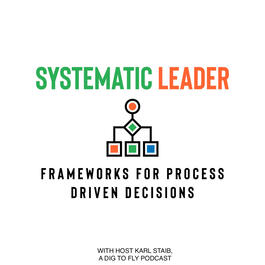
Your Story Is the Bridge to Their Trust with Matthew Dicks
Join Matthew Dicks and me for a conversation about storytelling. Matthew is a renowned author and storyteller competitor from the Moth storytelling events. The “First, Last, Best, Worst” storytelling exercise stood out as a powerful, practical tool for leaders to mine their own experiences for stories that engage and influence. By prompting reflection across different emotional anchors, it helps leaders build a bank of authentic, memorable narratives that resonate far more deeply than data or directives alone. You can get the Magnetic Systems Method (and other systems guides) to find issues before they become expensive problems. Highlights from the interview 1. Storytelling as a Leadership Skill Karl explains that the focus of the podcast is on leadership, systems, and storytelling. He notes that leaders need to do a better job of telling stories to engage their audience. Matthew agrees, emphasizing the importance of leaders developing stories that can draw people in and convey their message effectively. 2. The "First, Last, Best, Worst" Storytelling Exercise He shares a technique called "first, last, best, worst" that helps people excavate stories from their past. By creating a grid to capture the first, last, best, and worst experiences related to different topics, it prompts people to uncover meaningful stories they may have forgotten. Matthew explains how this exercise can help leaders build a repertoire of stories to use in their work. 3. The Power of Stories to Connect and Influence We discuss the psychological and neurological reasons why stories are so powerful for communication and influence. Stories can change brain chemistry, foster connection, and help people remember information better than facts or data alone. Matthew emphasizes that as leaders, telling stories should be a core part of how they engage and motivate their teams. 4. Telling Stories with Empathy and Avoiding Content Matching He shares strategies for telling stories that resonate, such as listening closely to understand the underlying meaning and feelings behind someone else's story, and then responding with an empathetic story of your own that connects on an emotional level rather than just matching the content. He explains how this approach can help build trust and rapport as a leader. 5. A Personal Story Demonstrating Growth and Perspective Shift He shares a story from his own life about writing a letter to Steven Spielberg as a child, critiquing a scene in the movie E.T. He reflects on how this early experience sparked his interest in storytelling and his tendency to analyze stories for what works and what doesn't. The story illustrates Matthew's lifelong fascination with stories and how they can shape our perspectives. 6. Final Thoughts We wrap up the discussion, with Karl noting how the storytelling techniques Matthew shared could be applied in both professional and personal contexts, such as with his own teenage son. Matthew reiterates the importance of leaders strategically choosing when and how to share stories to build trust and connection with their teams. Learn more about Matthew Dicks over at his website of the same name. You can also connect with him on LinkedIn. You can get the Magnetic Systems Method (and other systems guides) to find issues before they become expensive problems. As always, if you have any questions or want to submit an amazing guest for the podcast, just reach out to me on the Systematic Leader website, and I’ll do my best to get them on. If you enjoy the interview, please take 30 seconds to rate the Systematic Leader podcast on your favorite platform. Thanks!
From "Systematic Leader"


Comments
Add comment Feedback